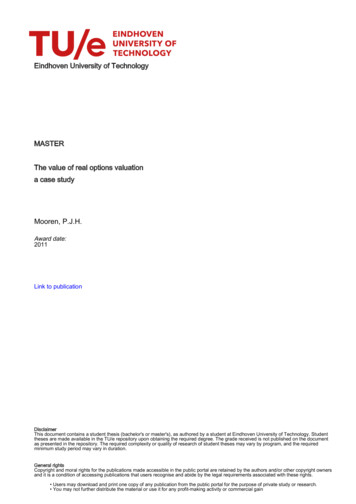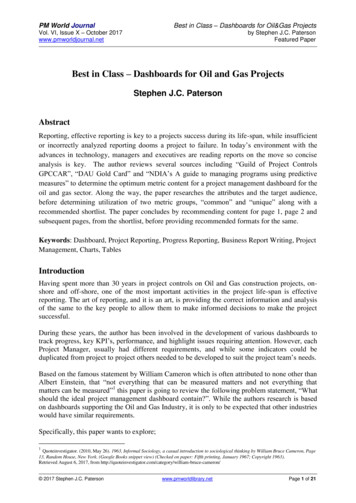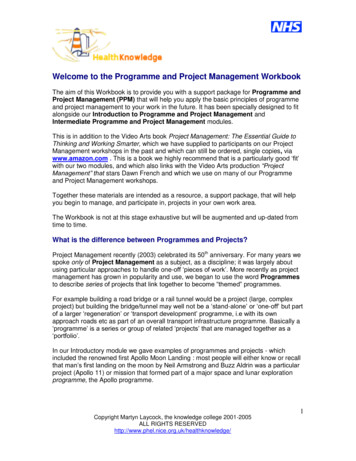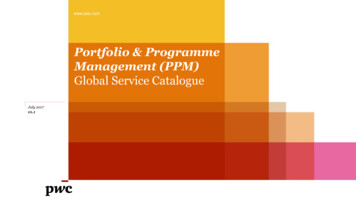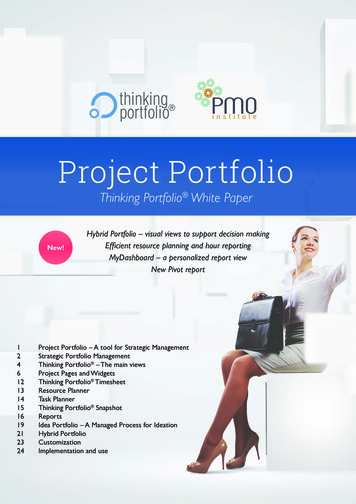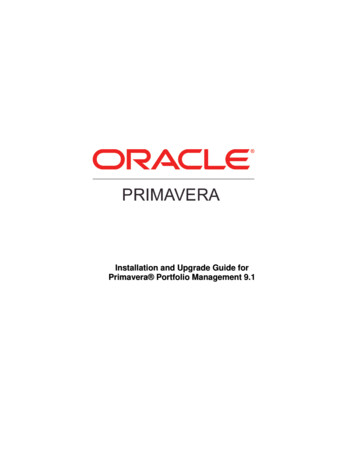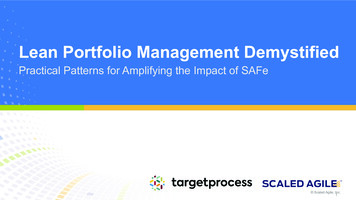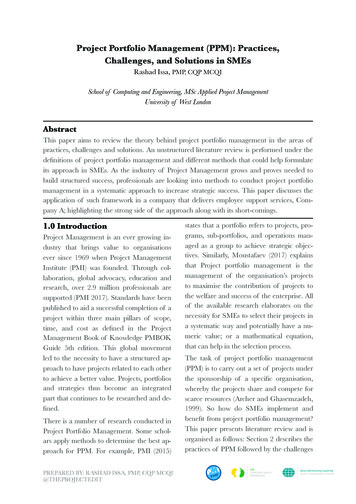
Transcription
Project Portfolio Management (PPM): Practices,Challenges, and Solutions in SMEsRashad Issa, PMP, CQP MCQISchool of Computing and Engineering, MSc Applied Project ManagementUniversity of West LondonAbstractThis paper aims to review the theory behind project portfolio management in the areas ofpractices, challenges and solutions. An unstructured literature review is performed under thedefinitions of project portfolio management and different methods that could help formulateits approach in SMEs. As the industry of Project Management grows and proves needed tobuild structured success, professionals are looking into methods to conduct project portfoliomanagement in a systematic approach to increase strategic success. This paper discusses theapplication of such framework in a company that delivers employee support services, Company A; highlighting the strong side of the approach along with its short-comings.1.0 IntroductionProject Management is an ever growing industry that brings value to organisationsever since 1969 when Project ManagementInstitute (PMI) was founded. Through collaboration, global advocacy, education andresearch, over 2.9 million professionals aresupported (PMI 2017). Standards have beenpublished to aid a successful completion of aproject within three main pillars of scope,time, and cost as defined in the ProjectManagement Book of Knowledge PMBOKGuide 5th edition. This global movementled to the necessity to have a structured approach to have projects related to each otherto achieve a better value. Projects, portfoliosand strategies thus become an integratedpart that continues to be researched and defined.There is a number of research conducted inProject Portfolio Management. Some scholars apply methods to determine the best approach for PPM. For example, PMI (2015)PREPARED BY: RASHAD ISSA, PMP, CQP MCQI@THEPROJECTEDITstates that a portfolio refers to projects, programs, sub-portfolios, and operations managed as a group to achieve strategic objectives. Similarly, Moustafaev (2017) explainsthat Project portfolio management is themanagement of the organisation’s projectsto maximise the contribution of projects tothe welfare and success of the enterprise. Allof the available research elaborates on thenecessity for SMEs to select their projects ina systematic way and potentially have a numeric value; or a mathematical equation,that can help in the selection process.The task of project portfolio management(PPM) is to carry out a set of projects underthe sponsorship of a specific organisation,whereby the projects share and compete forscarce resources (Archer and Ghasemzadeh,1999). So how do SMEs implement andbenefit from project portfolio management?This paper presents literature review and isorganised as follows: Section 2 describes thepractices of PPM followed by the challenges
of PPM in SMEs in section 3. Section 4talks about some of the proposed solutionsfollowed by section 5 presents the recommendations of PPM implementation inSMEs, while section 6 presents the conclusion.2. PPM PracticesProject portfolio management is applied andpracticed within a framework that continuesto be defined under research. Large companies have been practicing PPM for a whileto obtain value from the overall project/portfolio performance. This has not yet cascaded properly or been adopted by SMEs.Several authors proposed a framework thatfocuses on the methodology of R&Dprojects/portfolio selection and evaluation,in early research (Patanakul, Curtis, & Koppel 2013).In addition, anything that can bemeasured can be improved (Moore, 2010).With the assumption that SME have a strategy in place, the above explains how the aproject/portfolio should be evaluated.Having a process to evaluate the output ofthe portfolio would undoubtedly lead to enhanced value. The European Standard defines the importance of having a processapproach in a quality management systemas necessary for continual improvementbased on objective measurement (CEN,2008). The three pillars that constitutesPPM are value, a balanced portfolio and astrategic fit as defined (Mustafaev, 2017).This ties in nicely with the definition fromthe European standard that an organisationshould have a strategic decision to deploy aquality management system with the potential benefit of facilitating opportunities toenhance customer satisfaction (CEN, 2015).Similarly, firms should adopt a proactiveapproach to ensure that customer percepPREPARED BY: RASHAD ISSA, PMP, CQP MCQI@THEPROJECTEDITtion of the service is positive (Tan, 2011).This proactive approach can also be accompanied by a a structured methodology. TheScoring Model is one of the common methods and models for Project Portfolio Selection (Benaija, K.; Kjiri, L., 2015). While thescoring model has some limitations as identified by Jeffrey Pinto (2012), it is still considered a valuable model for prioritisation ordecision support (Cooper, R., Edgett, S. andKleinschmidt, E., 2001). It is found that astructured method that gives guidance totop management in decision making is always welcomed.At Company A, the project portfolio management is managed top down. The organisation focuses on customer satisfaction andshapes its strategy around this importantmetric. The CEO and COO set the visionfor the company. The top management thencollectively agrees on five business goals toachieve the vision. Each functional headthen comes up with a list of objectives thatties into the five business goals. And becausethe continuous evaluation of metrics thatare measured potentially leads to improvement (Moore, 2010; CEN, 2015), a governance committee has been formed. Thiscommittee helps each function break downtheir objectives into projects. Each projectmust have a high level estimated benefit thatties into the business goal. Then projects arethen aligned with the resource availability inthe operations side of the organisation, anda priority is set of the top projects to moveforward in line with customer requests. Ofcourse this approach has paused some constraints and challenges which some scholarshave already identified.
3. PPM ChallengesOne size does not fit all. And because business circumstances change constantly, having of the shelf framework would pause itsown challenges. This research has identifiedtwo main challenges within PPM practice:organisations resources are not beingaligned with the business goals, and the impact of a non evidenced non rational decision making processes have.Resources are not always aligned with thebusiness strategic objective. Some departments could have their entire teams workingon a project that does support the enhancement of an organisation’s strategy.More than 50% of organisations say theirprojects and resources are not well alignedwith business goals is the first stat TusharPatel shared in his article about the 5 Portfolio Management findings (PMI, 2015). Thisis a major problem when organisation continue to seek efficiencies and value. Similarly, organisations are having to adapt andevolve more quickly than ever before in response to shifting demands by customers,challenges from competitors, and opportunities created by emerging technologies asstated by Andy Jordan (PMI, 2017). Equally,a strong framework can only lead an organisation so far (PWC, 2012).In the same way that resources are notaligned to strategic projects is detrimental tothe success of a portfolio, lack of factual decision making process is another challengethat faces portfolio. One explanation wasprovided that human beings have cognitivelimitations when analysing and interpretinginformation, and that, in practice, they operate under the absence of complete information (Gutiérrez E, Magnusson, M. 2014).A level of discipline will demand standardPREPARED BY: RASHAD ISSA, PMP, CQP MCQI@THEPROJECTEDITised key performance indicators (KPIs) andpowerful analytics to deliver objective insight for proactive decisions (PWC, 2012).At Company A, both of those challengestranslate true. Prior to the organisation deciding to implement a PPM, each functiondetermined its own objectives in silo basedon their own interpretation of value andsuccess. The dilemma of contributing to thestrategy while still responding to client requests has led to signifiant changes that werenot based on factual decisions. With the absence of readily available data highlightinginformation of strategy and each of theportfolios, in the moment decisions weremade to accommodate isolated circumstances.This expresses the true challenge projectportfolio management faces. When there isno specific measure for success in a portfolio, it is difficult to define success. In a studymade on five companies that deploy projectportfolio management in different degrees,there was still a lack of specific measure thatdetermines a portfolio’s success. Each company focused on the success of a specificproject within a portfolio (Patanakul, Curtis,& Koppel 2013). And that is exactly whatCompany A did.When PPM was introduced, there had to bestakeholders consensus on what successlooks like in terms of KPIs for the strategyas a whole, as well as availability of resources to support these objectives. Thisprocess required a robust governance approach that would commence at the veryfirst stage of planning.
4. PPM SolutionsCompanies need to be able to see their vastportfolio of projects in order to tend to projects that are working on the organisationsmost critical needs (EPMA, 2014). A systematic decision making process can helpachieve better results in project portfoliomanagement. The European Standardpromotes the PDCA (see Fig 1: PDCA cycle)approach which can be applied to any process. It is defined as Plan: establishing theobjectives, policies, procedures; Do: implementing what was planned; Check: monitoring and measuring the processes and theoutputs and reporting on them; and Act:taking action to improve on performancewhere necessary (CEN, 2015). But who willperform such duties?Fig. 1: PDCA CycleHaving a PfMO can have benefits on companies. The optimal PfMP solution in specific situations will depend on number offactors, one of which is governance and decision making structures as explained byShan Rageopal (2013). Rajegopal continuesthat PfMO will provide information, analysis, and insights to help ensure that executivesand governance boards have visibility andcontrol over delivery of overall portfolio toPREPARED BY: RASHAD ISSA, PMP, CQP MCQI@THEPROJECTEDITachieve business objectives. This approachmeans that an organisation would have dedicated resources to carry on the duties forthe PfMO.When making resources available to carryon the duties of PfMO, a high level ofLeadership support is required. As MarkPerry presents (2011, p42) “While it is truethat PPM requires a high degree of processadherence, also required are reservedpowers for key members of the leadershipteam and especially the executives whopresides over the organisation.” This compliments what Rajegopal stated (2013,p15-16) “On the commitment side arespoonsrship and cultural change; fundingand risk taking; and rewards and recognition.” This is needed to ensure that a potentially successful solution is implemented. Because as an action research with a transportsolutions firm (Olsson, 2008) identified thattop managers need visibility to risk commonalities and trends in the portfolio. A riskin one project may mean opportunity foranother (Martinsuo, 2013). So there has tobe an office in place overseeing the data thatis coming from different projects to ensureevidence based decisions can take place bythe executives for a successful strategy.Similarly, The UK government published abook on the topic of programme management called Managing Successful Programmes(The Stationary, 2003). The book breaksdown programme management in simpleterms to three facets, of which the first oneis Project Portfolio Management. The publications explains that PPM is process whereall ideas for project are analysed in a consistent and thorough manner before anywork commences (Reiss, 2007). This analysis
would need to be carried out by resourcesthat have access to the data.At Company A, the executives wanted tomake fact-based decision but lacked accessto continuous data. In a fast growing company, lack of data visibility to the portfoliobecomes a hinderance. That is when an approval came to appoint someone who canmake this data available. The approach wasfollowed in two facets:1. A resource is available to produce regularreports to all stakeholders involved on5. Recommendations of PPMImplementation in SMEsThe methodologies presented to manage asuccessful project portfolio management environment continue to being explored.While various practices are defined, the application of it is highly dependant on thecontext and the culture of the organisation.The practice in real life is messier than thetheory (Martinsuo, 2013). Organisationmust obtain and customise their ownframework to better drive results from theirportfolio. A set of best practices layered ontop of a strong framework is needed to ensure execution excellence and an optimisedROI (PWC, 2012). What David Lavinskymentioned in his book Start at the End(2012), once a company has a vision, it canapply it to reverse engineer a business planto achieve it. This approach is found morevaluable to an SME. Once the end goal isobtained, applying this reverse engineerwould help SME determine the milestonesand/or KPIs to get to the end goal. It willalso help them define the level of resourcesneeded to get there while maintaining andrunning the day to day operations.intervals of quarterly basis. This approach replaced a bi-annual conference.2. A platform that encourages collaborationand increased visibility for those intervalswhen reports are not yet available. Allrelevant stakeholders have access to theplatform and the appointed resource ensured that any customised adhoc reporting is available as a default search optionfor them.At Company A, the company applied thisreverse methodology by identifying the endgoal at the end of five years. Objectiveswere then created collectively with eachfunctional head to help the companyachieve the end goal. All Objectives werethen mapped across all 5 years and a list ofprojects were identified. Figure 1: Order ofplanning shows the order. Once the list ofprojects is identified, the level of involvement from each function is then determineto start mapping out the resources needed.Once the maximum capacity of resources isreached, additional projects are added to theon hold list to revisit when when a projectcompletes. All of this happened with thesupport of an established governance and aplatform that makes data available and visible to all relevant stakeholders.VisionGoalsObjectivesProjectsPREPARED BY: RASHAD ISSA, PMP, CQP MCQI@THEPROJECTEDITFig. 2: Order of strategic planning
Governance, which ensures that all organisation requirements are reflected in operational frameworks, policies, processes andplans, and that these meet all stakeholdersrequirement (The CQI, 2017), was set up inthe form a steering committee. The committee supports the leadership team in deploying the framework to all functions, reviewresource availability, project delivery andvalue. All of this information had to bemade available to the management at everyreview meeting to make fact-based decisionsfor any changes that would impact the portfolio.The research has identified that while theframework applied at the organisation ofCompany A is customised and supportsgovernance and resource allocation, the ap-proach to scoring model is missing. Scoringmodel shows that it allows the business tohave certain KPIs that they deem necessaryas defined in section 2. Because, in an organisation, not all departments are staffed inan equal capacity, having KPIs to rateprojects helps the company be more focused. When the executives hold an strategicretreat, one solution could potentially involve a collaborative determination of theKPIs that are deemed necessary. Once theKPIs are determined, the Project Management Office will then list all the identifiedprojects against the agreed KPIs and ask thestakeholders to vote.An example of the KPIs that could be considered (table 1) and the weighting relevantto it (table2):Table 1. Five KPIs to be used for scoring projectsProject Name \ KPIInnovationROICost ct 1Project 2Project 3Project 4Table 2. Weighting defined per each KPIKPI \ %21% and moreCost Cutting 100,000 100,000 250,000 250,000 Competitive AdvantageLowMediumHighEmployee Engagement5% retention5%-15% retention15% retention5.0 ConclusionThe objective of this study was to provide astock of the practices of project portfoliomanagement and some of the challengesPREPARED BY: RASHAD ISSA, PMP, CQP MCQI@THEPROJECTEDITand solutions that can be implemented inSMEs. The Project Portfolio Managementin SMEs continues to be a subject for research and application. Drawing on the re-
search performed, the PPM practices hasbeen established in large organisations. Thepractice involves having a method in placeto evaluate the selection process of a portfolio, the output of the portfolio, and the impact the portfolio has on the positive perception of customers. All of this requires tohappen in a proactive approach.For SMEs to adopt these practices, theyneed to ensure that they have resourcesavailable to carry on such practices. Somestudies highlight that a large number of organisations do not utilise their workforce inalignment to the strategy. When resourcesare not aligned strategically, decisions thatare situational based rather than evidencebased become easier to make, thus, potentially deviating the organisation from achieving its overall strategy. The importance ofhaving factual and evidence based decisionis always flagged as detrimental for a company’s success.For decisions to be based on facts and evidence, having a function of Project PortfolioManagement is one of the proposed solutions. This requires leadership support to becarried out. This leadership support wouldthen be extended to ensure that resources(human and non human) are available toenhance the process of data collection andanalysis. Hence, a platform that makes thedata available could be perceived as a solution.Based on the field research that was made, itwas found that the process is entirely drivenby the leadership commitment. The vision,goals, objectives are defined; then in turn,supporting the selection of projects. Thedefinition of what success look like becomesPREPARED BY: RASHAD ISSA, PMP, CQP MCQI@THEPROJECTEDITvery valuable to ensure that all functionaldepartments are working in collaborationwith the aim to achieve the company’s strategy.Limitations and constraints:This study has paused several questions inthe lifecycle of project portfolio management which were not covered in this research.1. What triggers the need in an organisationto have a PPM approach? Is it failure,lack or direction, or the need to grow?2. If resources are to be made available inSMEs, how will organisations make fundsavailable if they had no previous exposure to the benefits of PPM?3. SMEs that are in the start up phase, andwith the assumption that they have astrategy in place, how will resources (human and non human) be made availableto continually evaluate the progress of thestrategy and its portfolio?4. If an SME decided to adopt the PPMapproach for the first time, what processwill be applied to help stakeholders identify the desired benefit realisation and theKPIs that progress will be measuredagainst.These limitations pause a potential need forresearch to identify the practices and proposed solutions to address them. The newresearch could potentially help in establishing an approach that shapes the PPM fromthe infancy stage in SME. Because the keybenefit of stakeholder engagement is to increase support and minimise resistance toachieve success (PMBOK Guide, 2015).
References Archer, N.P., Ghasemzadeh, F.,1999. An integrated frameworkfor project portfolio selection.International Journal of ProjectManagement Page 207–216. Benaija, K.; Kjiri, L. (2015)'Hybrid approach for projectportfolio selection based on thebusiness strategy and the scoring model’, Innovative ComputingTechnology (INTECH), 2015 FifthInternational Conference doi:10.1109/INTECH.2015.7173476 European Standards 9001:2008, CEN. Quality Management Systems. European Standards 9001:2015, CEN. Quality Management Systems. Gutierres, E. & Magnusson, M.(2011) ‘Dealing with legitimacy: A key challenge for ProjectPortfolio Management decisionmakers’, International Journal ofProject Management Page 30-39,doi: https://doi.org/10.1016/j.ijproman.2013.01.002 Jordan A. (2017) Agile in thePortfolio retrieved 348/Agile-in-the-Portfolio PMI, (2013) A Guide to theProject Management Body ofKnowledge (PMBOK Guide)–Fifth Edition. US Kindle Edition, Project Management Institute. Tam, J. 2011. The moderatingeffects of purchase importancein customer satisfactionprocess: An empirical investigation. Honk Kong: John Wiley& Sons, Ltd (wileyonlinelibrary.com) Martinsuo, M. (2013), Projectportfolio management in prac-tice and in context, International Journal of ProjectManagement 31 Page 794–803 Moustafaev, J. (2017) ProjectPortfolio Management in Theory and Practice: Taylor andFrancis Group. Lavinski, D. (2012) Start at theEnd: How Companies CanGrow Bigger and Faster by Reversing Their business Plan.US: Wiley, John Wiley & SonsInc, John Wiley & Sons, Incorporated, John Wiley & Sons,Wiley-Blackwell Moore, S. (2010) StrategicProject Portfolio ManagementEnabling a Productive Organisation. Canada: John Wiley &Sons, Inc., Hoboken, New Jersey Patanakul, P., Curtis, A., &Koppel, B. (2013) Effectivenessin Project Portfolio Management. US: Project Management Institute, Inc. Pedersen, K., & Nielsen, J. A.(2011). Managing Uncertaintyand conflict in IT Project Portfolio Management. Journal ofInformation Technology Caseand Application Research,13(4), 51-83. Retrieved fromhttp://ezproxy.uwl.ac.uk/login?url untid 14769 Patel, T. (2015) 5 PortfolioManagement Findings Retrieved from 5-Portfolio-Management-Findings Perry, M. (2011) Business Driven Project Portfolio Management, Conquiering the Top 10Risks that Threaten Success:US, J. Ross PublishingPREPARED BY: RASHAD ISSA, PMP, CQP MCQI@THEPROJECTEDIT Pinto, J. (2016), Project Management Achieving Competitive Advantage: Boston, Pearson. PWC, (2012) ‘Strategic portfolio management: How governance and financial disciplinecan improve portfolio performance’, p4/11 PPM solutions provider,EPMA, named top 100 mostpromising Microsoft solutionproviders. (2014, Aug 12). PRNewswire Retrieved fromhttp://ezproxy.uwl.ac.uk/login?url ountid 14769 Project Management Institute(2017) www.pmi.org Rajegopal, S. (2013) PortfolioManagement, How to innovateand invest in SuccessfulProjects: Great Britain, Palgrave Macmillan Reiss, G. (2007) Project Management Demystified: US, Taylor & Francis The Chartered Quality Institute (2017) www.quality.org Voss, M (2012), Impact of customer integration on projectportfolio management and itssuccess—Developing a conceptual framework, InternationalJournal of Project ManagementPage 567–581
Guide 5th edition. This global movement led to the necessity to have a structured ap-proach to have projects related to each other to achieve a better value. Projects, portfolios and strategies thus become an integrated part that continues to be researched and de-fined. There is a number of research conducted in
